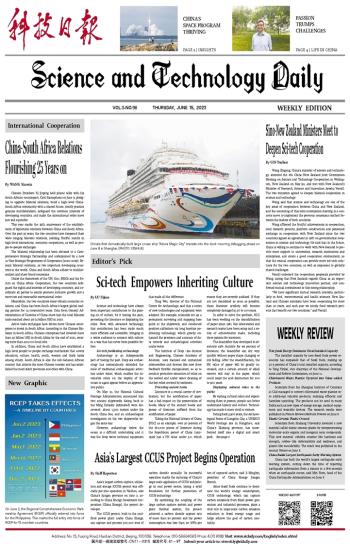
 WEEKLY EDITION
WEEKLY EDITION CHINA'S SPACE PROGRAM THRIVING PAGE 3 | INSIGHTS
CHINA'S SPACE PROGRAM THRIVING PAGE 3 | INSIGHTS PASSION TRUMPS CHALLENGES PAGE 4 | LIFE IN CHINA
PASSION TRUMPS CHALLENGES PAGE 4 | LIFE IN CHINA Sino-New Zealand Ministers Meet to Deepen Sci-tech Cooperation
Sino-New Zealand Ministers Meet to Deepen Sci-tech Cooperation Photo News
Photo News China-South Africa Relations Flourishing 25 Years on
China-South Africa Relations Flourishing 25 Years on Sci-tech Empowers Inheriting Culture
Sci-tech Empowers Inheriting Culture WEEKLY REVIEW
WEEKLY REVIEW New Graphic
New Graphic Asia's Largest CCUS Project Begins Operation
Asia's Largest CCUS Project Begins Operation WECHAT ACCOUNT & E-PAPER
WECHAT ACCOUNT & E-PAPER
Science and technology have always been important contributors to the passing on of culture, be it tracing the past, protecting the literature or displaying the relics. Now, with advanced technology, this contribution has been made much more efficient and accessible, bringing in a wider audience to connect with culture in a way that has never been possible before.
Sci-tech facilitating archaeology
Archaeology is an indispensable part of tracing the past. Deep sea archaeology has tremendously extended the scale of traditional archaeological activities under water, which enables the invaluable relics on the depths of the ocean to again appear before an appreciative public.
On May 21, the National Cultural Heritage Administration announced that two ancient shipwrecks dating back to the Ming Dynasty (estimated) were discovered about 1,500 meters under the South China Sea, and an archaeological investigation on the two shipwrecks began the same day.
However, archaeology below the ocean is a difficult undertaking and it was the deep water technical equipment that made all the difference.
Tang Wei, director of the National Centre for Archaeology, said that a series of new technologies and equipment were adopted. For example, scientists set up a permanent surveying and mapping base point at the shipwreck, and conducted position calibration via long baseline positioning technology, which greatly enhanced the precision and accuracy of data records and archaeological activities under water.
The Institute of Deep -sea Science and Engineering, Chinese Academy of Sciences, uses manned and unmanned submersibles and devices like new force feedback flexible manipulators, so as to conduct protective extraction of relics on the seabed and under water cleaning of the key relics covered by sediment.
Protecting ancient books
Literature is a crucial carrier of civilization, but the acidification of paper has a bad impact on the preservation of books. Many of the ancient books and pieces of literature suffered from the acidification of paper.
Taking the National Library of China (NLC) as an example, over 50 percent of the 670,000 pieces of literature during the Republican period of China (1912-1949) has a PH value under 5.0, which means they are severely acidized. If they are not deacidized as soon as possible, these literature artifacts will become completely damaged in 50 to 100 years.
In order to solve the problem, NLC has been working on the deacidification of paper since 1981. Key laboratories and research teams have been setup and a series of achievements made, including three patents for invention.
The deacidifier they developed is absolutely safe. Suitable for 99 percent of literature, the deacidifier can dry very quickly without paper shape changing or ink fading. After the deacidification, the PH value of paper will be greatly increased, and a certain amount of alkali reserve will stay in the paper, which could resist the acid destruction for 200 to 300 years.
Displaying cultural relics to the public
By visiting cultural relics and experiencing them in person, people can better understand history and culture. Technology has made it more vivid to visitors.
Dating back 5,300 years, the Archaeological Ruins of Liangzhu City, a UNESCO World Heritage site in Hangzhou, east China's Zhejiang province, has transformed itself into a digital and smart park. See page 2

 Next
Next



